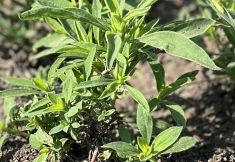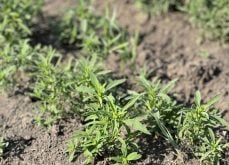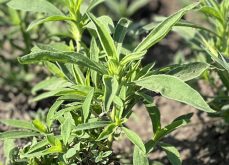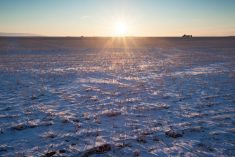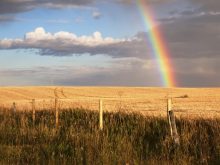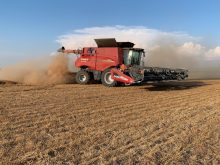Farmers Owen Orsak and Tim Nerbas hadn’t got the 2022 crop in the ground yet when they were asked in early May about their fall weed control plans, but the Manitoba and Saskatchewan producers, respectively, say they will apply desiccation and weed control measures on their farms this year depending on weed growth and harvest timing and conditions.
Orsak, who crops about 5,000 acres of wheat, peas, canola and some oats at Binscarth in west-central Manitoba, not far from the Saskatchewan border, says he most commonly applies pre-harvest treatments, but with it being so dry last year, it was one of the few years he can remember when he applied post-harvest weed control to about half of the farm.
In northwest Saskatchewan, Nerbas, of NRG Farms near Waseca located about 30 minutes southeast of Lloydminster, says he usually does a bit of both pre- and post- harvest treatments on about 4,000 acres of crops, which includes wheat, oats, barley, canola, flax and faba beans.
Read Also

Claas brings 1000 Series SP forage harvesters to Canada
In mid-August, Claas unveiled its new line of Jaguar forage harvesters at an event in Visalia, California, deep in the heart of that state’s dairy region.
Orsak says usually harvest runs a bit late, so applying post-harvest weed control isn’t always an option.
“In 2019, we combined about 1,400 acres in the snow,” says Orsak. “But then last year, it was so dry the peas were harvested by August 6 and the wheat came off early as well. It was a dry growing season, so there wasn’t much weed growth, so we did zero pre-harvest. But then there was a bit of rain in August, which brought on a few weeds, so we did about half the farm post-harvest.”

Most years Orsak follows a pre-harvest weed control program — with the only exception being no treatment to the oat acres. The oats are produced under contract for milling so no pre-harvest product is applied. And he also doesn’t apply any pre-harvest herbicides to any wheat they plan to harvest for their own homegrown seed.
Peas are usually treated with a pre-harvest application of Reglone, mostly to dry down the crop for harvest management. “It usually helps to brown off a few weeds as well,” he says.
Most years the wheat acres receive a pre-harvest application of glyphosate with no additives. The exception again being if Orsak identifies an area of the farm where kochia appears to be a problem.
“If I see kochia then I use a tank mix of glyphosate with a Group 14 product such as Heat from BASF,” he says. “It is effective against kochia and I like having that Group 14 in there to reduce the risk of selecting for herbicide-resistant kochia.”
Orsak doesn’t apply the tank mix to whole fields. “I’ll mix up a tank and then hit those areas in perhaps a few fields where there may be some kochia,” he says. “The rest of the wheat is treated with straight glyphosate.”
As he applies in-crop herbicides and often a fungicide, Orsak does his best to follow the same sprayer wheel tracks when applying the pre-harvest treatments. “I’m not full on with controlled traffic farming, but every time I make a pass with the sprayer, it runs over about two per cent of the crop. So, particularly with the pre-harvest treatment, I don’t want to knock down three-foot-tall wheat and make it four per cent of the crop. I do my best to keep the sprayer in the same wheel tracks as the fungicide.”
In 2021, with the early harvest, he applied straight glyphosate post-harvest to about half of the farm. “I think it is important to be flexible depending on growing conditions, and also keep economics in mind,” he says.
Stocking up in late 2021, Orsak says he has glyphosate requirements for the 2022 growing season in storage on the farm, with probably some left over for the start of 2023. “Who knows what supplies will be like, so it works for us to stock up in December for the coming year,” he says. “Glyphosate is quite comfortable in our chemical storage shed.”

In Northwest Saskatchewan
Nerbas makes notes of any weed problems he sees in different fields and different crops during the growing season, and that helps with his plans for pre-harvest weed control measures.
“If we see there is a problem with thistle or some other weed, for example, I make a note and then treat those fields with a pre-harvest application of glyphosate,” he says.
With faba beans, he uses a pre-harvest application of Reglone to help mature and dry down the crop, while with flax he applies a pre-harvest treatment of glyphosate to help even out maturity.
“If the harvest is early enough, then we usually apply a post-harvest treatment in some fields as well,” Nerbas says, noting that timing is an issue. There is a cut-off date of roughly September 20-25 for effective post-harvest herbicide application. Often by the third week of September, they’ve already had a killing frost, so herbicide needs to be applied before that.
With a dry growing season in 2021, which suppressed both crop and weed growth, he was able to do some post-harvest treatments. There was also a bit of rain in August and early September, which stimulated some weed growth as well.
With drought-like growing conditions in 2021, Nerbas says he had subpar yields — wheat and canola yielded about 80 per cent of normal, while the rest of the crops yielded about 50 per cent of normal.
Nerbas says there appears to be decent moisture to get the 2022 crop growing, but rain will be needed. He has booked his herbicide products for this coming growing season, but it will be wait and see if those products will be available when needed.
Weather can play a role
Extreme weather conditions, particularly hot and dry conditions, can play a role in how farmers approach later-season weed control, says Clark Brenzil, provincial weed control specialist with Saskatchewan Agriculture.
“If it is really hot and dry during the growing season — extreme conditions like we saw in some areas last year — perennial weeds will shut down early,” says Brenzil. In that situation, a pre-harvest herbicide application to control weeds may not be very effective.
Brenzil says taprooted perennials, such as dandelion and Canada thistle, may be able to draw on deeper moisture reserves and keep growing, but he suspects in some areas last year even that deeper ground moisture had disappeared too.
In extremely dry conditions, perennial weeds can shut down early, however, if there is moisture later on — even a bit of rainfall in August and September — weeds will be revived.
“Late summer, early fall moisture can kick-start growth of perennial weeds again, as well as the winter annuals, so then farmers may need to be prepared for post-harvest weed control measures,” says Brenzil.
The cycle of wetter and drier growing seasons is no surprise to farmers, he says. The early 2000s saw growing seasons with higher moisture, and now much of Western Canada has been in a drier cycle since about 2017. The 2019 growing season had a bit more moisture but then 2020 and 2021 were extremely dry.
Producers in southern Alberta and southern Saskatchewan are more familiar with the dry cycles, whereas the drier conditions reaching into the northern half of Alberta and Saskatchewan and across much of Manitoba is somewhat of a new experience.
Brenzil says as of early May, there is some “glimmer of hope” that moisture conditions will be improved in 2022, but then he admits “his crystal ball gets a bit fuzzy.”

Kochia control is all about timing
When it comes to dealing with kochia control with pre- and post-harvest herbicides, timing is critical, says Charles Geddes, weed research scientist at the Agriculture and Agri-Food Canada Lethbridge Research and Development Centre.
Geddes, who has been looking at herbicide timing to control kochia across Western Canada, says a pre-harvest treatment to get the weed dried down so the crop can be harvested is effective, but an early post-harvest treatment can be even more effective in reducing kochia numbers.
“Kochia has an indeterminant growth pattern, so it just keeps growing,” says Geddes. “If you have a heavy patch of kochia in a crop, a producer may need to get it killed or dried down just so they can combine the crop.”
A pre-harvest treatment with a tank mix such as glyphosate and a Group 14 (Heat, for example) will dry down the kochia. And data from a study at 10 research sites across Western Canada shows that a pre-harvest treatment will also reduce the number of viable seeds by about 20 per cent. “It’s not a huge reduction, but it is better than nothing,” says Geddes.
The bigger bang for your buck comes if you can get a post-harvest herbicide applied to kochia before September 1. “If the crop is harvested early and the farmer can apply a post-harvest weed control treatment by the end of August, that treatment will help reduce kochia seed production by about 75 per cent,” says Geddes. But if the crop is harvested at some point in mid- to late September, there is really no point in making a post-harvest treatment targeting kochia. It will be too late.
“With any weed control program, it is important for farmers to know which weeds are present and understand their growth cycle,” says Geddes. “With kochia, for example, it is a summer annual, so it grows and produces seed in late summer, but those plants will not survive the winter anyway.”
They’ve done their job, they’ve produced seed that will germinate the next year, and fall frost will take them out. Geddes says research shows the key control measure is to get the herbicide applied before the weed produces seed — the early pre-harvest treatment will reduce seed production to some extent, but the early post-harvest treatment before September 1 will have a much greater benefit in reducing weed seed production.
One more thought on timing
One other approach that fits into the post-harvest weed control window is to apply one of the more common pre-seed weed control products in the fall for a dual benefit.
Tammy Jones, technical agronomist with Corteva Canada, points out spring is a hectic time for fieldwork, and depending on the year, field conditions may not be suitable to apply pre-seed weed control measures before the crop goes into the ground.
She adds that Corteva has some excellent pre-seed products that can do double duty if applied in the fall before freeze-up.
“Korrex II, PrePass and Paradigm Pre can all be applied in the fall to help control a range of weeds such as dandelion, Canada thistle, and volunteer canola along with winter annuals,” says Jones. “And then their effectiveness will extend to control early-emerging weeds in the spring.”
Jones also points out that controlling weeds early in the growing season has a season-long benefit in reducing weed pressure. “Prospect herbicide, for example, tank mixed with glyphosate and applied ahead of canola seeding will provide excellent control of some of the toughest broadleaf weeds, including cleavers and hemp nettle,” says Jones.
She adds that effective weed control prior to seeding may take some of the pressure off in crop — provide producers with a bit more flexibility or breathing room — if there is a supply shortage of some popular chemistries.




